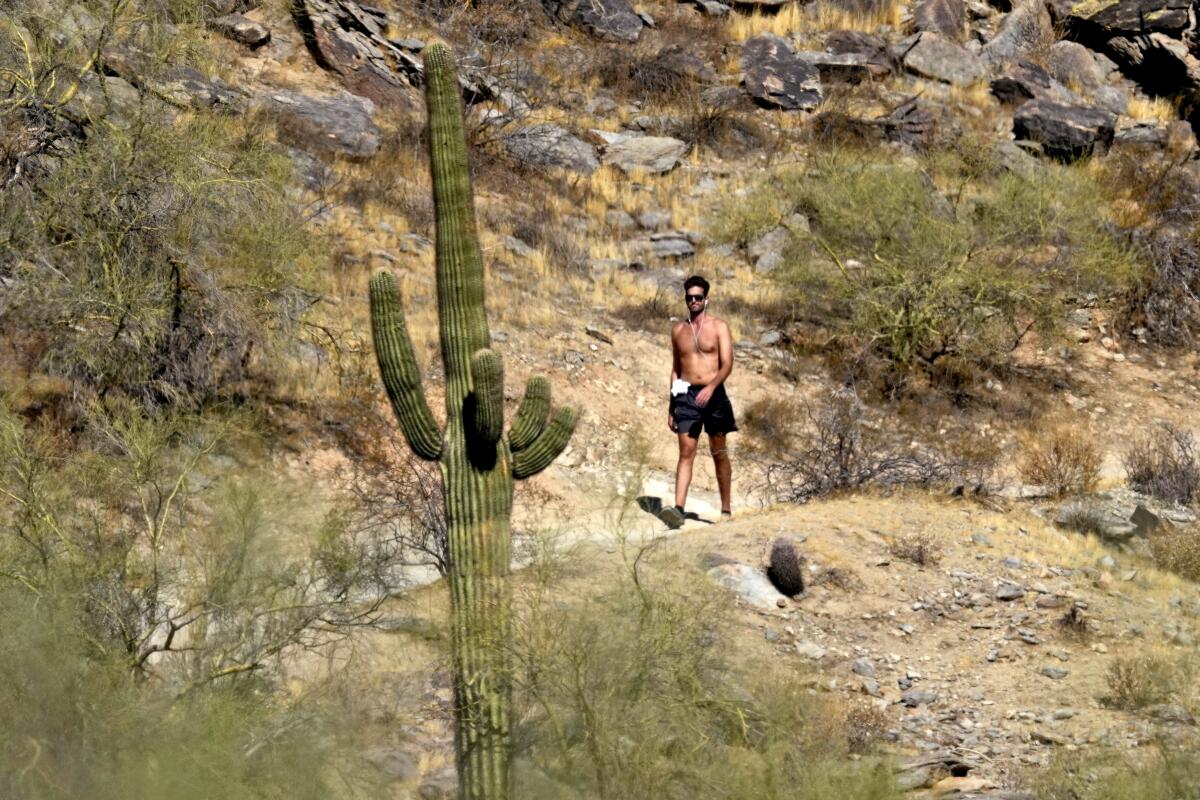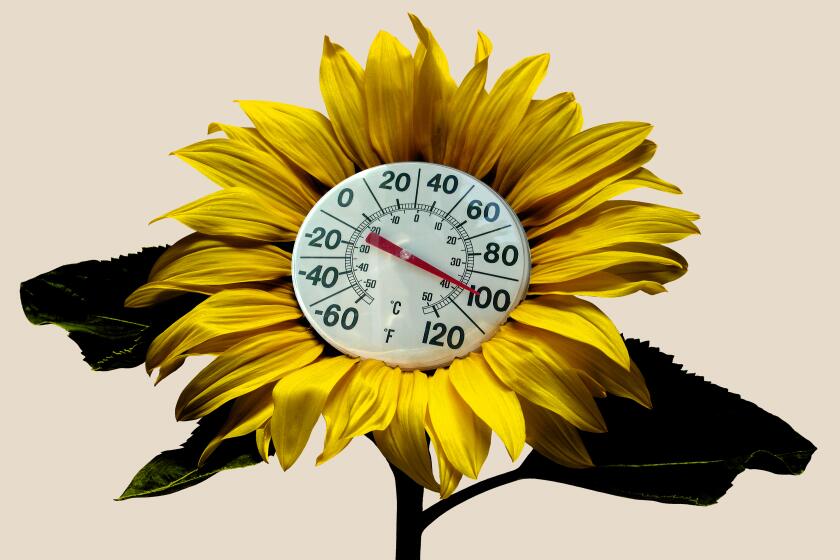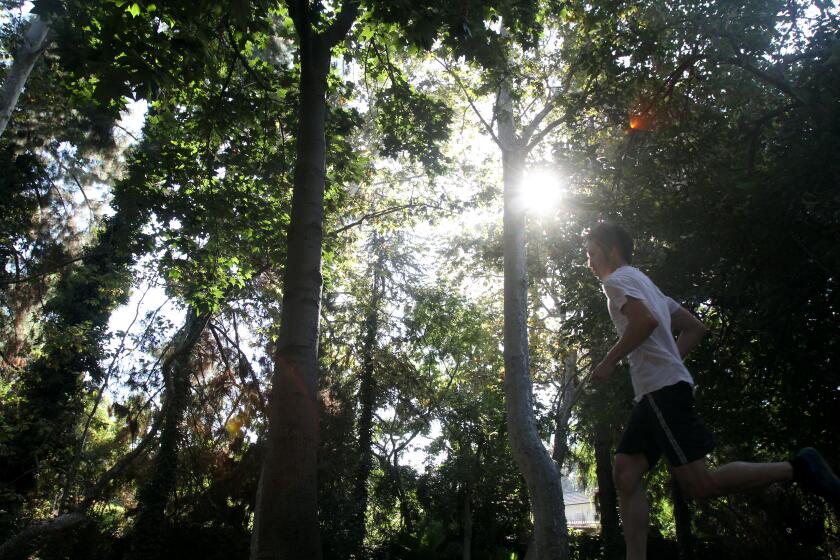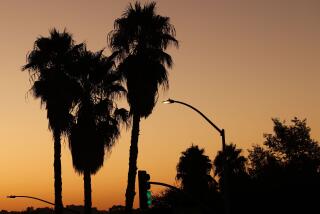100 days of 100-degree misery: A summer of relentless, oppressive heat across the West

- Share via
To get an idea of how the forces of climate change and extreme heat are transforming the West, consider the summer Phoenix has endured.
On Wednesday, the city experienced the 101st day in a row with temperatures topping 100 degrees, with little relief in sight.
Residents of the desert city are used to broiling summers, but 2024 has been one for the record books.
Southern California is dealing with dangerous triple-digit temperatures. Here are tips for keeping your plants alive when the weather is sweltering.
At SixPoints Hardware, BreAnna Larson said her customers have been coming in to buy personal fans and anything they can get their hands on to stay cool while working on construction sites.
Larson, who has lived in Phoenix for six years, said this summer’s sweltering heat is nothing like anything she has experienced. The cooling system at her apartment complex has already failed three times this summer because of the excessive heat.
“It has really shown [how] the impact of dark pavements and such can heat up the city, as well as increase electricity bills,” she said.
Phoenix is expected to see triple-digit temperatures for the foreseeable future; it’s supposed to stay above 110 degrees until at least Friday and remain in the mid- to upper 100s for the next seven days, according to the National Weather Service.
“This year, the heat started early and it’s been persistent,” said NWS meteorologist Ted Whittock. “We haven’t really had a break. This is, on average, the record hottest summer for the Phoenix area.”
Southern California is in the midst of a heat wave that is expected to last through the weekend. But it’s nothing compared to the conditions in some of parts of the West that are no strangers to extremes.
In Las Vegas, it reached a whopping 120 degrees July 7, surpassing the city’s previous daily high of 117 degrees. As of a few days ago, forecasters declared 2024 the hottest summer on record for Sin City.
On July 5, Palm Springs broke its previous all-time high temperature when it reached 124 degrees.
Heat waves cause many of us to alter our daily routines. But how should you care for your furry friend when temperatures rise? Try these 7 tips
July was the hottest month in Death Valley’s recorded history, with the average daily temperature hitting 108.5 degrees and the average daily high reaching 121.9 degrees.
While California’s climate has always had year-to-year and month-to-month variability, the heat the state has experienced recently is consistent with climate change, according to Jane Baldwin, assistant professor of earth system science at UC Irvine.
“These are levels of heat that are extreme and are what we generally expect to see more of as the climate system warms,” she said, although she added that more analysis needs to be done to determine whether this is going to be the new normal for California.
While September heat waves are relatively commonplace, said UCLA climate scientist Daniel Swain, this one is still notable for bringing anticipated temperatures as high as 115 degrees to coastal Southern California.
For the majority of the Southwest, it was the hottest summer on record, although that hasn’t been the case for coastal areas of California, Swain said.
“This heat event will actually be the most notable of the year so far in coastal SoCal, where temperatures will make it into the upper 90s within just a few miles of the beaches and could locally end up as hot as 110-115 [degrees] in portions of the San Fernando Valley,” Swain wrote on his blog.
The extreme heat has also increased the chance for heat-related illness. In Clark County, Nevada, there were at least 181 heat-related deaths as of the end of August.
Willi Henderson, an employee at the Municipal Pool in Las Vegas, has seen an influx of customers. Homeless people will come to the lobby just to get a break from the heat, while families are taking their kids to the indoor pool.
In the past month, around 4,500 people have come to the pool alone, according to the 45-year-old Las Vegas resident. Outside the summer months, the numbers are roughly half that.
Oaks, sycamores and willows line these chill routes.
“I’m not trying to do all the outside activities during the summer,” Henderson said. “I try to stay inside and stay hydrated.”
The brunt of the heat wave is anticipated to hit between Wednesday and Friday, ushering in temperatures between 110 and 115 degrees in the San Fernando Valley. Downtown Los Angeles could see temperatures in the mid- to high 90s, according to the weather service.
By Thursday, it could reach 106 degrees and 118 degrees in Santa Clarita and Palm Springs, respectively.
The weather service issued an excessive heat warning from 11 a.m. Wednesday until 8 p.m. Friday for most of Los Angeles County. Overnight temperatures in the 70s and 80s aren’t expected to bring much relief from the heat.
The current heat wave isn’t expected to shatter any temperature records in Los Angeles County. The region endured a particularly blistering heat wave around this time in 2020, when Woodland Hills, traditionally the hottest place in L.A., recorded an all-time high of 121 degrees.
But that doesn’t mean it won’t be noteworthy.
“It’s going to be the most significant heat wave that we’ve had in the last several years,” said NWS meteorologist Todd Hall from the Oxnard office. “It’s basically a strong high-pressure system that’s driving a lot of this in Nevada and Utah as well. We’re seeing a weakening of onshore flow that’s creating the hot temperatures over the next several days.”
Los Angeles is an urban heat island, which is made hotter than nearby rural areas by heat-trapping surfaces such as concrete, asphalt and some types of roofing. Urban heat islands also tend to lack trees and shading for cooling.
Trees may not be able to solve all our problems but they can offer a reprieve on hot summer days. Here are several of our favorite places to find shade in the L.A. area.
The urban heat island effect results in people, particularly those in low-income communities of color, becoming more vulnerable to heat waves, Jo Tavares, the director of the California Center for Climate Change Education at West Los Angeles College, said.
“We know that most people who have the means are fine during heat waves. It’s a little uncomfortable when they are getting in and out of the house and their cars,” she said. “But the people who suffer the most are the ones who work in the fields, construction sites, or the elderly who are poor and living in apartments that don’t have proper air conditioning.”
The city’s disparity in climate resilience is even visible from neighborhood to neighborhood, Amir AghaKouchak, a UC Irvine civil and environmental engineering professor, said. More affluent areas are better protected from extreme heat with vegetation and shade, while poorer areas have less shade and air conditioning.
While people can’t stop heat waves from happening, he added, they can prepare as best they can for the sweltering conditions.
“[Having a water bottle] can be the difference between heat stroke or no heat stroke, especially for vulnerable populations,” AghaKouchak said.
Staff writer Hannah Fry contributed to this report.
More to Read
Sign up for Essential California
The most important California stories and recommendations in your inbox every morning.
You may occasionally receive promotional content from the Los Angeles Times.
















